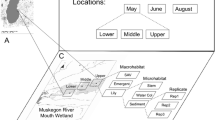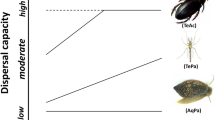Abstract
Both spatial processes and environmental control may structure metacommunities, but their relative importance may be contingent on the dispersal ability of organisms. I examined the roles of spatial and environmental factors for the structuring of littoral macroinvertebrate communities across a set of lakes in a boreal drainage basin. I hypothesized that dispersal ability would affect the relative importance of spatial processes and environmental control, and thus the biological data were divided into four groups of species differing in dispersal ability. In general, the group of the strongest aerial dispersers showed greatest relative pure environmental control and least pure spatial structuring of community structure and species richness, while spatial processes seemed to be more important for the other three dispersal ability groups. However, these results were contingent on the indirect measure of spatial processes, with the spatial variables and connectivity variables providing slightly different insights into the spatial processes and environmental control of metacommunity structuring. It appears, however, that dispersal ability has effects on the spatial processes and environmental control important in metacommunity organization, with strong dispersers being more under environmental control and less affected by spatial processes compared to weak dispersers.


Similar content being viewed by others
References
Anderson MJ, Gorley RN, Clarke KR (2008) PERMANOVA+ for PRIMER. Guide to software and statistical methods. PRIMER-E, Plymouth
Beisner BE, Peres-Neto PR, Lindström ES, Barnett A, Longhi ML (2006) The role of environmental and spatial processes in structuring lake communities from bacteria to fish. Ecology 87:2985–2991
Bilton DA, Freeland JR, Okamura B (2001) Dispersal in freshwater invertebrates. Annu Rev Ecol Syst 32:159–181
Borcard D, Legendre P (2002) All-scale analysis of ecological data by means of principal coordinates of neighbour matrices. Ecol Model 153:51–68
Borcard D, Legendre P, Drapeau P (1992) Partialling out the spatial component of ecological variation. Ecology 73:1045–1055
Chase JM, Bentgtsson J (2010) Increasing spatio-temporal scales: metacommunity ecology. In: Verhoef HA, Morin PJ (eds) Community ecology: processes, models and applications. Oxford University Press, Oxford, pp 57–68
Cottenie K (2005) Integrating environmental and spatial processes in ecological community dynamics. Ecol Lett 8:1175–1182
Cottenie K, Nuytten N, Michels E, De Meester L (2003) Zooplankton metacommunity structure: regional versus local biotic and abiotic processes in a set of interconnected ponds. Ecology 84:991–1000
Diniz-Filho JAF, Bini LM (2005) Modeling geographical patterns in species richness using eigenvector-based spatial filters. Glob Ecol Biogeogr 14:177–185
Faith DP, Minchin PR, Belbin L (1987) Compositional dissimilarity as a robust measure of ecological distance. Vegetatio 69:57–68
Gray DK, Arnott SE, Shead JA, Derry AM (2012) The recovery of acid-damaged zooplankton communities in Canadian Lakes: the relative importance of abiotic, biotic and spatial variables. Freshw Biol 57:741–758
Griffith DA, Peres-Neto PR (2006) Spatial modeling in ecology: the flexibility of eigenfunction spatial analyses in exploiting relative location information. Ecology 87:2603–2613
Hájek M, Roleček J, Cottenie K, Kintrová K, Horsák M, Poulíčková A, Hájkov P, Fránková M, Dítě D (2011) Environmental and spatial controls of biotic assemblages in a discrete semi-terrestrial habitat: comparison of organisms with different dispersal ability sampled in the same plots. J Biogeogr 38:1683–1693
Heino J (2008) Patterns of functional biodiversity and function-environment relationships in lake littoral macroinvertebrates. Limnol Oceanogr 53:1446–1455
Heino J (2011) A macroecological perspective of diversity patterns in the freshwater realm. Freshw Biol 56:1703–1722
Heino J, Muotka T (2006) Landscape position, local environmental factors and the structure of molluscan assemblages of lakes. Lands Ecol 21:499–507
Heino J, Mykrä H (2008) Control of stream insect assemblages: roles of spatial configuration and local environmental variables. Ecol Entomol 33:614–622
Heino J, Tolonen K, Kotanen J, Paasivirta L (2009) Indicator groups and congruence of assemblage similarity, species richness, and environmental relationships in littoral macroinvertebrates. Biodiver Conserv 18:3085–3098
Hoffsten P-O (2004) Site-occupancy in relation to flight morphology in caddisflies. Freshw Biol 49:810–817
Keddy PA (1992) Assembly and response rules: two goals for predictive community ecology. J Veg Sci 3:157–164
Landeiro VL, Magnusson WE, Melo AS, Espirito-Santo HMV, Bini LM (2011) Spatial eigenfunction analyses in stream networks: do watercourse and overland distances produce different results? Freshw Biol 56:1184–1192
Legendre P, Anderson MJ (1999) Distance-based redundancy analysis: testing multispecies responses in multifactorial ecological experiments. Ecol Monogr 69:1–24
Legendre P, Legendre L (1998) Numerical ecology. Elsevier, Amsterdam
Leibold MA, Holyoak M, Mouquet N, Amarasekare P, Chase JM, Hoopes MF, Holt RD, Shurin JB, Law R, Tilman D, Loreau M, Gonzalez A (2004) The metacommunity concept: a framework for multi-scale community ecology. Ecol Lett 7:601–613
Lewis DB, Magnuson JJ (2000) Landscape spatial patterns in freshwater snail assemblages across Northern Highland catchments. Freshw Biol 43:409–420
Lomolino MV (1982) Species-area and species-distance relationships of terrestrial mammals in the Thousand Island region. Oecologia 54:72–75
MacArthur RH, Wilson EO (1967) The theory of island biogeography. Princeton University Press, Princeton
Magnuson JJ, Tonn WM, Banerjee A, Toivonen J, Sanchez O, Rask M (1998) Isolation versus extinction in the assembly of fishes in small northern lakes. Ecology 79:2941–2956
Malmqvist B (2000) How does wing length relate to distribution patterns of stoneflies (Plecoptera) and mayflies (Ephemeroptera)? Biol Conserv 93:271–276
McArdle BH, Anderson MJ (2001) Fitting multivariate models to community data: a comment on distance-based redundancy analysis. Ecology 82:290–297
National Board of Waters and the Environment (1981) Vesihallinnon analyysimenetelmät. Publication of the National Board of Waters Finland, Report 213, pp 1–136
Nekola JC, White PS (1999) Distance decay of similarity in biogeography and ecology. J Biogeogr 26:867–878
Ng ISY, Carr CM, Cottenie K (2009) Hierarchical zooplankton metacommunities: distinguishing between high and limiting dispersal mechanisms. Hydrobiologia 619:133–143
Peres-Neto PR, Legendre P, Dray S, Borcard D (2006) Variation partitioning of species data matrices: estimation and comparison of fractions. Ecology 87:2614–2625
Prugh LR, Hodges KE, Sinclair AR, Brashares JS (2008) Effect of habitat area and isolation on fragmented animal populations. Proc Natl Acad Sci USA 105:20770–20775
Rahel FJ (1984) Factors structuring fish assemblages along a bog lake successional gradient. Ecology 65:1276–1289
Rangel TFLVB, Diniz-Filho JAF, Bini LM (2010) SAM: a comprehensive application for spatial analysis in macroecology. Ecography 33:46–50
Resetarits WJ, Binckley AA (2009) Spatial contagion of predation risk affects colonization dynamics in experimental aquatic landscapes. Ecology 90:869–876
Riera JL, Magnuson JJ, Kratz TK, Webster KE (2000) A geomorphic template for the analysis of lake districts applied to the Northern Highland District, Wisconsin, USA. Freshw Biol 43:301–318
Soininen J, MacDonald R, Hillebrand H (2007) The distance decay of similarity in ecological communities. Ecography 30:3–12
Soininen J, Korhonen JJ, Karhu J, Vetterli A (2011) Disentangling the spatial patterns in community composition of prokaryotic and eukaryotic lake plankton. Limnol Oceanogr 56:508–520
Thompson R, Townsend CR (2006) A truce with neutral theory: local deterministic factors, species traits and dispersal limitation together determine patterns of diversity in stream invertebrates. J Anim Ecol 75:476–484
Tonn WM, Magnuson JJ (1982) Patterns in the species composition and richness of fish assemblages in northern Wisconsin lakes. Ecology 63:1149–1166
Van De Meutter F, De Meester L, Stoks R (2007) Metacommunity structure of pond macroinvertebrates: effects of dispersal ability and generation time. Ecology 88:1687–1695
Acknowledgments
I thank Pekka Majuri and Kimmo Sivonen for conducting the field work, Juho Kotanen for providing the GIS variables, and Lauri Paasivirta for identifying midge larvae. Timo Muotka, Janne Soininen, two anonymous reviewers and the editors provided excellent comments on the manuscript. Water chemistry analyses and other logistical support were provided by Oulanka Research Station. This study was supported by grants from the Academy of Finland (to J. Heino and T. Muotka).
Author information
Authors and Affiliations
Corresponding author
Additional information
Communicated by Carla Caceres.
Rights and permissions
About this article
Cite this article
Heino, J. Does dispersal ability affect the relative importance of environmental control and spatial structuring of littoral macroinvertebrate communities?. Oecologia 171, 971–980 (2013). https://doi.org/10.1007/s00442-012-2451-4
Received:
Accepted:
Published:
Issue Date:
DOI: https://doi.org/10.1007/s00442-012-2451-4




